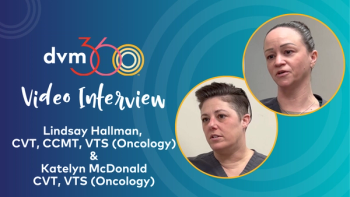
Clinical applications of holistic medicine for veterinary technicians (Proceedings)
Holistic medicine has many different definitions, misconceptions and perspectives depending on who one talks to. It encompasses many varied modalities.
Holistic medicine has many different definitions, misconceptions and perspectives depending on who one talks to. It encompasses many varied modalities. The AVMA defines holistic veterinary medicine as "a comprehensive approach to health care employing alternative and conventional diagnostic and therapeutic modalities. .. It incorporates, but is not limited to, the principles of acupuncture and acutherapy, botanical medicine, chiropractic, homeopathy, massage therapy, nutraceuticals, and physical therapy, as well as conventional medicine, surgery and dentistry" The AVMA " recommends that holistic veterinary medicine be practiced by only licensed veterinarians educated in the modalities employed and that the modalities comprising holistic veterinary medicine be practiced according to the licensure and referral requirements concerning each modality
It is beyond the scope of this presentation to review all of holistic veterinary medicine. The topics discussed will be directed towards the practical applications that veterinary technicians may be of benefit in assisting in according to state licensure and requirements.
Fundamentals of holistic medicine
Numerous terms exist to define this emerging field. This eclectic field of study and practice has been termed holistic, alternative, complementary, integrative, natural as well as other titles. This presentation is based on the AVMA definition but the implications of each term will be clarified. Controversies regarding this field are discussed and resources for research and clinical applications are cited. Holistic medicine is utilized for diagnostic , preventive and therapeutic purposes. From a holistic diagnostic perspective, one looks at all possible causes of disease including nutritional, environmental as well as infectious and traumatic etiologies. From a preventive perspective, holistic medicine views nutrition as the foundation for all preventive medicine. This includes a high quality pet food as well as preventive nutritional supplements. Preventive nutritional options are reviewed.
Therapeutic options included in holistic medicine, in addition to conventional medicine and surgery, include nutritional supplements, acupuncture, chiropractic, physical therapy, botanical medicine, homeopathy and other miscellaneous therapies. Some of these therapies are limited to veterinary use and others may be used by veterinary technicians under the guidance of a veterinarian. Nutritional guidance can be an integral component of a veterinary technicians knowledge. Technicians should be educated in regards to the quality of ingredients in pet foods and the therapeutic benefits of certain nutraceuticals. For instance the benefits of essential fatty acid supplements in the treatment of dermatologic conditions and the use of chondroprotective agents in the treatment of degenerative joint disease should be discussed with appropriate clients.
Acupuncture therapy is limited to veterinarians. However, all veterinary technicians should be trained in the use of acupuncture for cardiovascular resuscitation techniques. A specific acupuncture point located on the nasal philtrum just ventral to the nares has a sympathomimetic effect, stimulating endogenous epinephrine release, accelerating the recovery time in cardiac and respiratory suppression and arrest.
One of the major areas where technicians can be of great assistance in holistic medicine is in rehabilitative medicine. Various massage techniques , physical therapy , low level photon or cold laser therapy and electromagnetic therapy can be of benefit in the recovery and rehabilitation of animals post-operatively or during convalescence from a chronic disease and during hospitalization. Physical therapy such as swimming, stretching and massage can help accelerate recovery by increasing mobility and maintaining muscular integrity. These therapies should be incorporated into all long term post-operative recovery programs, especially in cases of spinal surgery and posterior paralysis cases. Training programs for veterinary technicians in physical therapy are available through the University of Tennessee veterinary school.
If veterinary technicians are trained in botanical medicine or homeopathy , these may also be of benefit as adjunctive therapies for acute or chronic conditions. The concepts of homeopathy and botanical medicine will be briefly discussed. The use of the homeopathic remedy arnica can be of benefit in the treatment of any traumatic injury or postoperative recovery. The use of botanical medicines such as kava may be of benefit in relieving the anxiety associated with hospitalization . Some technicians are utilizing aromatherapy and bach flower remedies , extracts from various plants, in the palliative treatment of emotional imbalances in pets. Herbal and homeopathic remedies for emergency situations are reviewed.
Conclusions
The use of various holistic techniques including physial therapy, nutritional supplements, botanical medicine, aromatherapy, bach flower remedies as well as others by veterinary technicians can be of great benefit to companion animals during their hospitalization time. These modalities may be incorporated into a veterinary technicians training in order to benefit the animals under their care. These therapies should be integrated into a comprehensive approach for the patients in their care in a professional manner under the guidance of their veterinarians.
References
American Veterinary Medical Association Directory , Guidelines on alternative and complementary therapies, AVMA, Schaumburg, Il., 1996.
Smith, F., Acupuncture for Cardiovascular Disorders, Ed. A. Schoen, Veterinary Acupuncture, Ancient Art to Modern Medicine, Mosby, Inc., St. Louis MO., 1994. 199-206.
Porter, M., Bromiley, M., Massage Therapy, Ed. A. Schoen, Complementary and Alternative Veterinary Medicine, Principles and Practice, Mosby Inc., St. Louis, MO., 1998. 213-216.
M. Porter, Physical Therapy, ed. A. Schoen Complementary and Alternative Veterinary Medicine, Principles and Practice, Mosby Inc., St. Louis, MO., 1998. 201-212.
Pontinen, P., Low-Energy Photon Therapy, Ed. A. Schoen Complementary and Alternative Veterinary Medicine, Principles and Practice, Mosby Inc., St. Louis, MO., 1998. 247-274.
Hudson, D., Magnetic Field Therapy, Ed. A. Schoen Complementary and Alternative Veterinary Medicine, Principles and Practice, Mosby Inc., St. Louis, MO., 275-298.
Guzman, E., Western Herbal Medicine, Clinical Applications, Ed. A. Schoen Complementary and Alternative Veterinary Medicine, Principles and Practice, Mosby Inc., St. Louis, MO., 337-378.
Schwartz, C. Chinese Herbal Medicine in Small Animal Practice, Ed. A. Schoen Complementary and Alternative Veterinary Medicine, Principles and Practice, Mosby Inc., St. Louis, MO., 437-450.
Day, C., Veterinary Homeopathy, , Ed. A. Schoen Complementary and Alternative Veterinary Medicine, Principles and Practice, Mosby Inc., St. Louis, MO.,485-514.
Wynn, S., Aromatherapy, Ed. A. Schoen Complementary and Alternative Veterinary Medicine, Principles and Practice, Mosby Inc., St. Louis, MO., 561-578.
Blake, S., Bach Flower Therapy, Ed. A. Schoen Complementary and Alternative Veterinary Medicine, Principles and Practice, Mosby Inc., St. Louis, MO., 579-588.
Newsletter
From exam room tips to practice management insights, get trusted veterinary news delivered straight to your inbox—subscribe to dvm360.





